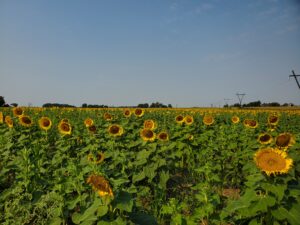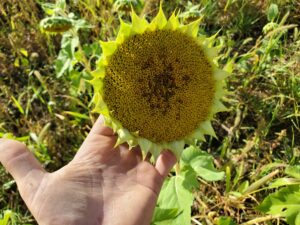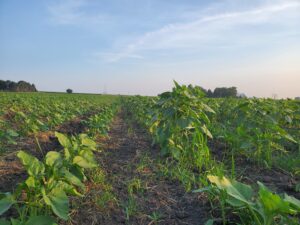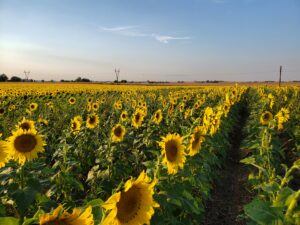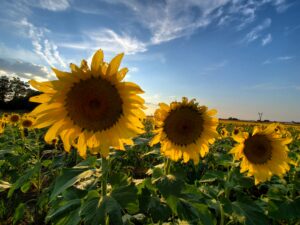Final report for FNC21-1287
Project Information
Our family has a certified organic dairy and grain farm in Whiteside County IL. My parents have been certified since 2008. In the last 5 years my brothers and I came back to the farm, began to take over the management of the family operations, and establish our own business entity. Combined, we manage about 1000 acres of certified organic crop and pasture ground. Prior to this grant our family practiced cover cropping and within the last 4 years began experimenting with crops not traditionally grown in Northern Illinois such as field peas and oilseed sunflowers.
Are double crop sunflowers a profitable option in organic systems in Northern Illinois?
Organic farms depend on diverse rotations to help manage pest and disease issues. The traditional organic crop rotation is corn - soybeans - small grain. In the Midwest, corn and soybeans are the primary cash crops. Small grains or forages are used in the rotation to help break up weed growth cycles and provide space in the summer for cover crops to grow. Small grains are often not as profitable and are often grown at financial loss or breakeven depending on fixed operation costs. While cover crops can provide much of the fertility needed for following seasons, the savings in fertility costs do not always make up for a loss in cashflow or profit in areas where land costs are high.
In some locations, soybeans can be grown as a double crop after wheat to provide an additional source of income on small grains acres. However, in areas north of Interstate 80, double crop soybeans become more risky due to early frosts and dry late summer periods.
Our research focused on trying to grow oilseed sunflowers after soft red winter wheat to see if they they can be grown profitably as a double crop in the Northern Illinois environment within an organic production system. Sunflowers are reportedly more drought tolerant and less susceptible to an early frost than soybeans. Beyond the general ecological and soil health benefit of adding an additional crop species to a rotation, sunflowers help support native pollinators and can help break up soil compaction with their deep taproots. They also provide a fun display of flowers for passers-by to enjoy in late summer.
Our research, conducted in 2021, explored if sunflowers can be grown profitably following winter wheat. Expenses were tracked across all field operations and income was calculated after the crop was sold and the settlement sheet received. Our research concluded that sunflowers may have the potential to provide a profit following winter wheat. Sub-optimal conditions such as a late planting date and less than adequate rainfall do make profitable sunflowers more difficult.
- Successfully establish oilseed sunflowers after harvesting winter wheat.
- Evaluate the profitability of sunflowers grown as a double crop behind winter wheat.
- Share findings through our YouTube channel, the IDEA Farm Network, and OGrain email group.
Research
The field consisted of approximately 30 contiguous certified organic acres bordered by a road on the south side and 30' buffer strips on 3 other sides. It was mostly flat with a gentle slope downhill to the north. The sunflower rows ran north/south.
Our project began by finding a buyer for the sunflower and securing a contract for the harvested seed. Not only did this help to secure a market but it also helped to ensure that we planted the variety of sunflower that the end user would want.
Next we grew and harvested our wheat crop, and baled the straw off. The wheat was fertilized with approximately 2 ton/ac of wet poultry litter in the early spring. The wheat was harvested July 5. We took care of small weeds with a soil finisher on July 8 and planted sunflowers July 9. The variety was N4H302, and it was planted at approximately 24,600 seeds/ac in 30in rows.
By July 14 we noticed that there was seed germination issues. In consultation with our seed supplier and other growers we discovered that we had a bad lot of seed. The summer was very dry so to preserve moisture we dragged the field aggressively with a spike tooth harrow and replanted over the old rows with Cobalt II, at 26,500 seeds/ac on July 23.
The sunflowers were rotary hoed once and cultivated once. Because of dry weather the weeds did not grow aggressively.
The field was fertilized with approximately 132lbs/ac of feather meal (13-0-0) in early August.
From July 1 to Sept 30 the field received only 4 inches of rain compared to a 5 year average of 14 in. In October the field did receive an additional 6 inches, but by then the sunflowers had already reached full maturity.
Attached are pictures of a few earlier planted sunflowers that managed to germinate compared to the shorter and smaller heads of the later planted sunflowers.
The sunflowers were harvested on November 20 with an R62 Gleaner combine and Gleaner 8000 grain platform that was blocked up in ridged position. Harvest moisture was around 14%.
The seed was stored in a bin with an aeration floor and dried with natural air to approximately 9% moisture and sold in March of 2022. Results of the study were then calculated from the Settlement sheet.
The results:
Costs:
- Seed: $1800
- Fertilizer plus application: $2596
- Machinery/Field opperations $1500
- Trucking/transportation $3000
- Total Cost for 30 acres: $8896
Income:
- Yield: 17,033lbs (567lb/ac)
- Price: $0.38/lb delivered
- Premium: Oil @ 46.5% = +$0.0342/lb
- Gross: $7055 for 30 acres
Gross - Cost = $7055 - $8896 = -$1841
The field lost approximately $61/ac. Breakeven would be 21,477lbs (715lb/ac)
In this test, the sunflowers as a double crop yielded a negative return. However, many variables led to this being a challenging season and strategic management could have led to a better financial outcome.
If the crop had germinated successfully the first time or if the replant could have taken place sooner it likely would have led to an increased yield. Timely rain could have also helped. It is also worth noting that the truck taking the crop to the end user was only half full, but the trucking was charged based on total milage. A fuller truck would have led to a more efficient hauling cost.
We also must consider that one of the largest expenses was the fertilizer cost. In a situation where there is limited rainfall it is common for farmers to withhold fertilizer to minimize expenses on a crop that might not reach it's potential. The feather meal that was used likely did not receive enough moisture to ever be plant available.
If we had skipped the fertilizer application it would have saved us $2596. Now the numbers are $7055 - $6300 =$755 or positive $25/ac.
If a farmer is strategic about their management decisions they can at least break even with sunflowers even under a "worst case" scenario where sunflowers are seeded very late and rains do not come.
Therefore, we can conclude that sunflowers have the potential to be a profitable double crop after winter wheat in Northern Illinois in an organic system. More testing is required to determine what profit might be possible during a more standard growing season.
Educational & Outreach Activities
Participation Summary:
The results were reported through an online presentation in January, 2023. The presentation was advertised primarily through the OGrain network, but others shared it within their personal networks as well. Approximately 13 people were in attendance and feedback was generally positive. The presentation was recorded and uploaded to YouTube and the link was shared across the OGrain and IDEA Farming networks. I was told it might be shared in an upcoming Practical Farmers of Iowa e-newsletter as well. As of Jan 27, 2022 over 220 people had "viewed" the presentation on YouTube. According to YouTube Analytics, as of Jan 27, 2023 about 88 people watched the entire presentation.
YouTube: Organic Double Crop Sunflowers SARE Research Project
Organic Double Crop Sunflowers in Northern Illinois (PDF of PowerPoint)
Learning Outcomes
Through our grant we had the courage to try a new way of growing sunflowers and learned important information about its ability to withstand stressful growing environments. We learned that sunflowers could be a profitable crop at best, and at worst be less risk than double crop soybeans in our northern area. The one disadvantage in this study is the poor growing conditions and unfortunate replant situation. It would have been nice to see how the sunflowers perform in a more typical season. Ideally this would be a multiple season experiment, and for a true comparison it would look more directly at double crop sunflowers and possibly even frost seeded clover to more broadly compare sunflowers to other late summer options following small grains.
In general, if a farmer is interested in growing a crop following a small grain, and soybeans are not a good option, I would recommend they consider sunflowers. There are numerous resources on the general agronomy of sunflowers from Northern Plains Universities and Universities in Canada.
Project Outcomes
One consultant from Ohio expressed affirmation in our findings.
One farmer in Northern Illinois decided to try full season sunflowers for 2024 based on our experiences with double crop sunflowers.
